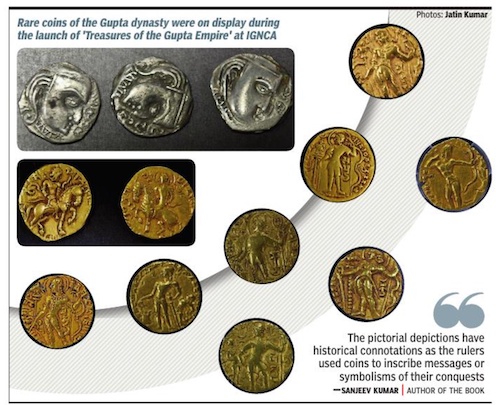Gupta Age/ Empire
This is a collection of articles archived for the excellence of their content. |
Coins
In collections across the world/ Sanjeev Kumar’s findings
Saket Suman, Sep 13, 2024: The Times of India

From: Saket Suman, Sep 13, 2024: The Times of India
New Delhi : Four decades of extensive research have led to some interesting new findings from the Gupta period. While the 240-550 CE reign of the Gupta dynasty is widely regarded as one of the most prosperous periods in Indian history, there remained significant gaps in the understanding of the era and how it saw Hinduism cementing its foothold in the Indian subcontinent. To this end, a researcher set out on a task to locate coins from the era in museums and private collections across the world to be able to trace a clearer and more objective picture of the societal and political developments that took place during the period.
The journey was not an easy one, as Sanjeev Kumar, who presented his findings to distinguished personalities from India’s art and culture domains, found. “The biggest problem was that the private collectors did not want to show these coins to others or allow them to be photographed to enable thorough research,” said Kumar, pointing to over a dozen coins from the Gupta period that he was able to source and study.
Those who heard Kumar, a numismatist, independent researcher and chairman of Shivlee Trust whose mission is to study the history of ancient India, included the heavyweights of India’s cultural landscape, prominent among them being Sacchidananda Joshi, chair and member secretary, IGNCA; BR Mani, director general, National Museum; and KK Thaplyal, professor emeritus, Lucknow University.
Kumar, who is a fellow of the Royal Asiatic Society of Great Britain, pointed out that even the museums that had these coins were not open to allowing researchers to study them. “It took as many as 40 years to gain a fuller understanding of the period and that was made possible because of these coins,” he said, before pointing out that rulers like Chandragupta II used the coins to inscribe tactical messages about conquests and victories. The findings, which have been documented in Kumar’s book, suggest, among other things, that the evolution of iconography of Hindu gods and goddesses was codified in this period. Kumar said that during the course of the research he was able to differentiate between the different figures of gods and goddesses. In particular, Hindu goddess of wealth Lakshmi was depicted in the form that she is currently associated with for the first time during the Gupta period, he claimed.
Presenting the coins to the audience, Kumar pointed out that the gods and goddesses mentioned in ancient Hindu scriptures of the Vedic period were textual and not pictorial, though there were elaborate descriptions of the divine. He said the Guptas inscribed stories in the ancient Brahmi script on the coins. The depictions and icons on these coins proved to be clues to gaining deeper insights into key developments. “These rare coins in gold, silver, and copper have hidden messages in them. When we studied these coins, we had to look at the entire landscape of that time. They have hidden messages and we decoded these to build a clearer understanding of the period,” said Kumar, who is also a trustee of the Hindu Temple of Northwest Indiana.
Kumar said that during this period, artists and writers were celebrated and were given patronage by the rulers. He informed the audience, among whom were college students, that literary, academic and intellectual figures like Kalidasa and Aryabhata gained prominence during this period while internationally renowned educational centres like the ancient Nalanda University prospered because the rulers were interested in and promoted the arts, heritage, astronomy, and intellectual pursuits of the subjects.
Maintaining that the public understanding of the Gupta period was limited, he stressed the need to revisit this golden era of history and retrace its significance in India's journey through the ages. He called on historians and researchers to delve deeper and wondered if the current understanding encapsulated all that happened in that period.